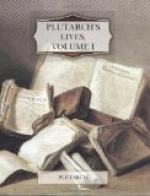The priests, who had been ordered by Camillus to mark out the boundaries where the temples had stood among the general wreck, when in their circuit of the Palatine Hill they came upon the chapel of Mars, found it, like every other building, destroyed and levelled to the ground by the Gauls, but while thoroughly examining the place they found the augur’s staff of Romulus hidden under a deep heap of ashes. This staff is curved at one end, and is called lituus. They use it to divide the heavens into squares when taking the auspices, just as Romulus himself did, as he was deeply skilled in divination. When he vanished from among mankind, the priests kept his staff just like any other sacred object. That at such a time, when all the other holy things perished, this should have been preserved, gave them good hopes of Rome, which that omen seemed to presage would be eternal.
XXXIII. Before they had finished rebuilding the city they became involved in a war, for the Aequians, Volscians, and Latins combined their forces and invaded the country, while the Etruscans besieged Sutrium, a city in alliance with Rome. The tribunes in command of the Roman forces encamped near the Marcian heights, and were there besieged by the Latins and in danger of having their camp taken. They sent to Rome for assistance, and the Romans appointed Camillus dictator for the third time. About this war there are two different accounts, of which I will mention the legendary one first:—It is said that the Latins, either merely as a pretext, or really wishing to amalgamate the two races as before, sent a demand to Rome for free unmarried women to be delivered up for them to marry. As the Romans were at their wits’ ends what to do, because they feared to go to war, being scarcely recovered from their late mishap, while they suspected that the women would be used as hostages if they gave them up, and that the proposal of intermarriage was merely a feint, a slave girl named Tutula, or, as some say, Philotis, advised the magistrates to send her and the best-looking of the female slaves, dressed like brides of noble birth, and that she would manage the rest. The magistrates




